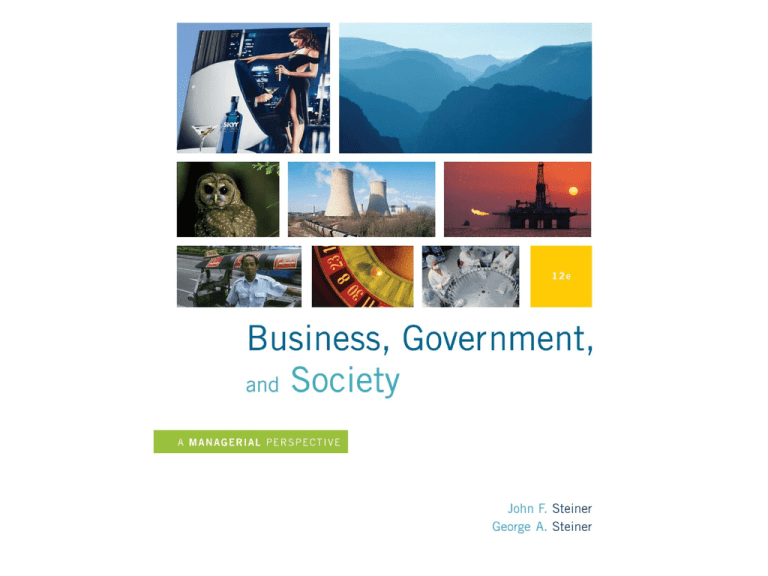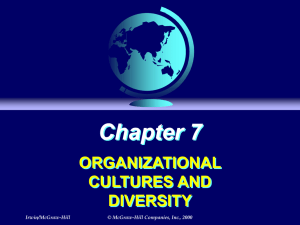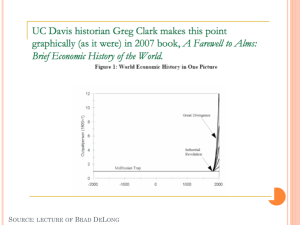
Chapter 1
The Study of Business,
Government, and Society
This chapter provides an overview of the business-governmentsociety field of study by:
Defining basic terms
Discussing the field’s importance to managers
Introducing the four basic models of the businessgovernment-society relationship
Explaining the authors’ approach to the subject matter.
McGraw-Hill/Irwin
© 2008 The McGraw-Hill Companies, Inc. All rights reserved
Opening Case:
ExxonMobil Corporation
Company history
Main business is discovering, producing, and
selling oil and natural gas
Descended from the Standard Oil trust
In 1890 Congress passed the Sherman Antitrust Act to
outlaw its monopoly
Once had more than a 90% market share of the
American oil market
The values of its founder, John D. Rockefeller,
defined the company culture
In 1972 Standard Oil of New Jersey changed its
name to Exxon, and in 1999 it merged with
Mobil, to form ExxonMobil
McGraw-Hill/Irwin
© 2008 The McGraw-Hill Companies, Inc. All rights reserved
Opening Case:
ExxonMobil Corporation (continued)
The leader
John D. Rockefeller (Standard Oil)
Brilliant strategist and organizer who
crushed competitors
Emphasized cost control, efficiency,
centralized organization, and suppression
of competitors
Although Rockefeller’s influence is buried in
the passage of time, ExxonMobil’s actions
remain consistent with his nature
McGraw-Hill/Irwin
© 2008 The McGraw-Hill Companies, Inc. All rights reserved
Opening Case:
ExxonMobil Corporation (continued)
Today ExxonMobil remains a powerful force, but that power is
limited by economic and political forces.
It now controls only 5.6% of oil production and holds less than
1% of petroleum reserves, far less than it did in the 1950s.
It has complex relationships with powerful governments.
For a considerable time, company managers denied that the
world is warming.
ExxonMobil’s large size attracts the watchful eye of
environmental, civil rights, labor, and consumer groups.
It engages in corporate citizenship by funding a variety of
programs to benefit education, communities, health, nature,
and the arts.
The story of ExxonMobil illustrates the importance of interactions
between one large corporation, governments, and society.
McGraw-Hill/Irwin
© 2008 The McGraw-Hill Companies, Inc. All rights reserved
What is the Business–
Government– Society Field?
Business – broad term encompassing a
range of actions and institutions.
Government – refers to structures and
processes in society that authoritatively
make and apply policies and rules.
Society – a network of human relations that
includes three interacting elements:
Ideas
Institutions
Material things
McGraw-Hill/Irwin
© 2008 The McGraw-Hill Companies, Inc. All rights reserved
How Institutions Support Markets
McGraw-Hill/Irwin
© 2008 The McGraw-Hill Companies, Inc. All rights reserved
Why is the BGS Field Important to
Managers?
To succeed in meetings its objectives a business
must be responsive to both its economic and its
noneconomic environment.
Recognizing that a company operates not only
within markets but within a society is critical.
A basic agreement or social contract exists
between the business institution and society.
Managers must respect and adhere to society’s
expectations.
This contract defines the broad duties that
business must perform to retain society’s
support, but these duties are often ambiguous.
McGraw-Hill/Irwin
© 2008 The McGraw-Hill Companies, Inc. All rights reserved
Four Models of the BGS Relationship:
The Market Capitalism Model
McGraw-Hill/Irwin
© 2008 The McGraw-Hill Companies, Inc. All rights reserved
Four Models of the BGS Relationship:
The Market Capitalism Model
(continued)
The market capitalism model depicts
business as operating within a market
environment, responding primarily to
powerful economic forces.
The market acts as a buffer between
business and nonmarket forces.
History and nature of markets
Adam Smith, The Wealth of Nations
Capitalism
Managerial capitalism
McGraw-Hill/Irwin
© 2008 The McGraw-Hill Companies, Inc. All rights reserved
Four Models of the BGS Relationship:
The Market Capitalism Model
(continued)
Important assumptions of the market capitalism
model:
Government interference in economic life is
slight (laissez-faire).
Individuals can own private property and freely
risk investments.
Consumers are informed about products and
prices and make rational decisions.
Moral restraint accompanies the self-interested
behavior of business.
Basic institutions such as banking and laws
exist to ease commerce.
There are many producers and consumers in
competitive markets.
McGraw-Hill/Irwin
© 2008 The McGraw-Hill Companies, Inc. All rights reserved
Four Models of the BGS Relationship
The Market Capitalism Model
(continued)
Critiques of the Market Capitalism Model
Increased prosperity comes at the cost of
increased inequality
Results in base values being energized and
virtue being eroded
The BGS relationship according to the Market
Capitalism Model:
Government regulation should be limited.
Markets discipline private economic activity to
promote social welfare.
The proper measure of corporate performance
is profit.
The ethical duty of management is to promote
the interests of shareholders.
McGraw-Hill/Irwin
© 2008 The McGraw-Hill Companies, Inc. All rights reserved
Four Models of the BGS Relationship:
The Dominance Model
McGraw-Hill/Irwin
© 2008 The McGraw-Hill Companies, Inc. All rights reserved
Four Models of the BGS Relationship:
The Dominance Model (continued)
Business and government dominate the
great mass of people, which results in the
enrichment of a few at the expense of
many.
Populist reform movement opposed the
dominance model.
Marxism emerged in Europe about the
same time.
Most accurate in the 1800s, but is being
resurrected due to the fear of transnational
corporations in a global context.
McGraw-Hill/Irwin
© 2008 The McGraw-Hill Companies, Inc. All rights reserved
Four Models of the BGS Relationship
The Countervailing Forces Model
McGraw-Hill/Irwin
© 2008 The McGraw-Hill Companies, Inc. All rights reserved
Four Models of the BGS Relationship
The Countervailing Forces Model
(continued)
Countervailing forces model conclusions:
Business is deeply integrated into an open society
and must respond to many forces, both economic
and noneconomic.
Business is a major initiator of change in society
through its interaction with government, its
production and marketing activities, and its use of
new technologies.
Broad public support of business depends on its
adjustment to multiple social, political, and
economic forces.
BGS relationships continuously evolve as changes
take place in the main ideas, institutions, and
processes of society.
McGraw-Hill/Irwin
© 2008 The McGraw-Hill Companies, Inc. All rights reserved
Four Models of the BGS Relationship
The Stakeholder Model
McGraw-Hill/Irwin
© 2008 The McGraw-Hill Companies, Inc. All rights reserved
Four Models of the BGS Relationship
The Stakeholder Model
Stakeholders are those whom the corporation
benefits or burdens by its actions and those who
benefit or burden the firm with their actions.
Primary stakeholders
Secondary stakeholders
Debate about how to identify who or what is a
stakeholder.
Stakeholder model is an ethical theory of
management in which the welfare of each
stakeholder must be considered as an end.
McGraw-Hill/Irwin
© 2008 The McGraw-Hill Companies, Inc. All rights reserved
Four Models of the BGS Relationship
The Stakeholder Model (continued)
Criticism of the stakeholder model:
It is not a realistic assessment of the power
relationships between the corporation and other
entities.
There is no single, clear, and objective
measure to evaluate the combined
ethical/economic performance of a firm.
Advocacy for the stakeholder model:
A corporation that embraces stakeholders
performs better.
It is the ethical way to manage because
stakeholders have moral rights that grow from
the way powerful corporations affect them.
McGraw-Hill/Irwin
© 2008 The McGraw-Hill Companies, Inc. All rights reserved
Text Approach to the
Subject Matter
Comprehensive scope
Interdisciplinary approach with a
management focus
Use of theory, description, and case
studies
Global perspective
Historical perspective
McGraw-Hill/Irwin
© 2008 The McGraw-Hill Companies, Inc. All rights reserved












